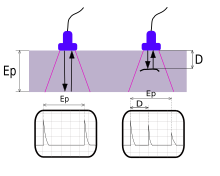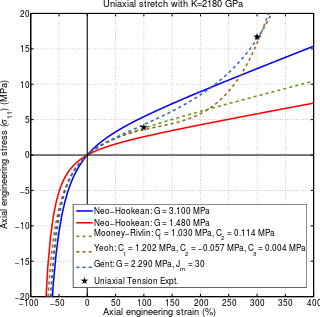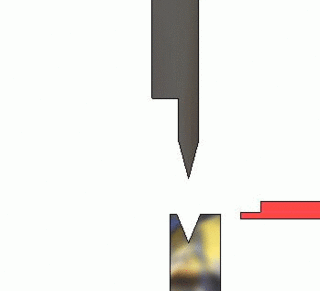The acoustoelastic effect is an effect of finite deformation of non-linear elastic materials. A modern comprehensive account of this can be found in. [1] This book treats the application of the non-linear elasticity theory and the analysis of the mechanical properties of solid materials capable of large elastic deformations. The special case of the acoustoelastic theory for a compressible isotropic hyperelastic material, like polycrystalline steel, [6] is reproduced and shown in this text from the non-linear elasticity theory as presented by Ogden. [1]
Constitutive relation – hyperelastic materials (Stress-strain relation)
A hyperelastic material is a special case of a Cauchy elastic material in which the stress at any point is objective and determined only by the current state of deformation with respect to an arbitrary reference configuration (for more details on deformation see also the pages Deformation (mechanics) and Finite strain). However, the work done by the stresses may depend on the path the deformation takes. Therefore, a Cauchy elastic material has a non-conservative structure, and the stress cannot be derived from a scalar elastic potential function. The special case of Cauchy elastic materials where the work done by the stresses is independent of the path of deformation is referred to as a Green elastic or hyperelastic material. Such materials are conservative and the stresses in the material can be derived by a scalar elastic potential, more commonly known as the Strain energy density function.
The constitutive relation between the stress and strain can be expressed in different forms based on the chosen stress and strain forms. Selecting the 1st Piola-Kirchhoff stress tensor  (which is the transpose of the nominal stress tensor
(which is the transpose of the nominal stress tensor  ), the constitutive equation for a compressible hyper elastic material can be expressed in terms of the Lagrangian Green strain (
), the constitutive equation for a compressible hyper elastic material can be expressed in terms of the Lagrangian Green strain ( ) as:
) as:

where  is the deformation gradient tensor, and where the second expression uses the Einstein summation convention for index notation of tensors.
is the deformation gradient tensor, and where the second expression uses the Einstein summation convention for index notation of tensors.  is the strain energy density function for a hyperelastic material and have been defined per unit volume rather than per unit mass since this avoids the need of multiplying the right hand side with the mass density
is the strain energy density function for a hyperelastic material and have been defined per unit volume rather than per unit mass since this avoids the need of multiplying the right hand side with the mass density  of the reference configuration. [1]
of the reference configuration. [1]
Assuming that the scalar strain energy density function  can be approximated by a Taylor series expansion in the current strain
can be approximated by a Taylor series expansion in the current strain  , it can be expressed (in index notation) as:
, it can be expressed (in index notation) as:

Imposing the restrictions that the strain energy function should be zero and have a minimum when the material is in the un-deformed state (i.e.  ) it is clear that there are no constant or linear term in the strain energy function, and thus:
) it is clear that there are no constant or linear term in the strain energy function, and thus:

where  is a fourth-order tensor of second-order elastic moduli, while
is a fourth-order tensor of second-order elastic moduli, while  is a sixth-order tensor of third-order elastic moduli. The symmetry of
is a sixth-order tensor of third-order elastic moduli. The symmetry of  together with the scalar strain energy density function
together with the scalar strain energy density function  implies that the second order moduli
implies that the second order moduli  have the following symmetry:
have the following symmetry:

which reduce the number of independent elastic constants from 81 to 36. In addition the power expansion implies that the second order moduli also have the major symmetry

which further reduce the number of independent elastic constants to 21. The same arguments can be used for the third order elastic moduli  . These symmetries also allows the elastic moduli to be expressed by the Voigt notation (i.e.
. These symmetries also allows the elastic moduli to be expressed by the Voigt notation (i.e.  and
and  ).
).
The deformation gradient tensor can be expressed in component form as

where  is the displacement of a material point
is the displacement of a material point  from coordinate
from coordinate  in the reference configuration to coordinate
in the reference configuration to coordinate  in the deformed configuration (see Figure 2 in the finite strain theory page). Including the power expansion of strain energy function in the constitutive relation and replacing the Lagrangian strain tensor
in the deformed configuration (see Figure 2 in the finite strain theory page). Including the power expansion of strain energy function in the constitutive relation and replacing the Lagrangian strain tensor  with the expansion given on the finite strain tensor page yields (note that lower case
with the expansion given on the finite strain tensor page yields (note that lower case  have been used in this section compared to the upper case on the finite strain page) the constitutive equation
have been used in this section compared to the upper case on the finite strain page) the constitutive equation

where

and higher order terms have been neglected [7] [8] (see [9] for detailed derivations). For referenceM by neglecting higher order terms in  this expression reduce to
this expression reduce to  which is a version of the generalised Hooke's law where
which is a version of the generalised Hooke's law where  is a measure of stress while
is a measure of stress while  is a measure of strain, and
is a measure of strain, and  is the linear relation between them.
is the linear relation between them.
Sound velocity
Assuming that a small dynamic (acoustic) deformation disturb an already statically stressed material the acoustoelastic effect can be regarded as the effect on a small deformation superposed on a larger finite deformation (also called the small-on-large theory). [8] Let us define three states of a given material point. In the reference (un-stressed) state the point is defined by the coordinate vector  while the same point has the coordinate vector
while the same point has the coordinate vector  in the static initially stressed state (i.e. under the influence of an applied pre-stress). Finally, assume that the material point under a small dynamic disturbance (acoustic stress field) have the coordinate vector
in the static initially stressed state (i.e. under the influence of an applied pre-stress). Finally, assume that the material point under a small dynamic disturbance (acoustic stress field) have the coordinate vector  . The total displacement of the material points (under influence of both a static pre-stress and an dynamic acoustic disturbance) can then be described by the displacement vectors
. The total displacement of the material points (under influence of both a static pre-stress and an dynamic acoustic disturbance) can then be described by the displacement vectors

where

describes the static (Lagrangian) initial displacement due to the applied pre-stress, and the (Eulerian) displacement due to the acoustic disturbance, respectively. Cauchy's first law of motion (or balance of linear momentum) for the additional Eulerian disturbance  can then be derived in terms of the intermediate Lagrangian deformation
can then be derived in terms of the intermediate Lagrangian deformation  assuming that the small-on-large assumption
assuming that the small-on-large assumption

holds. Using the Lagrangian form of Cauchy's first law of motion, where the effect of a constant body force (i.e. gravity) has been neglected, yields

- Note that the subscript/superscript "0" is used in this text to denote the un-stressed reference state, and a dotted variable is as usual the time (
 ) derivative of the variable, and
) derivative of the variable, and  is the divergence operator with respect to the Lagrangian coordinate system
is the divergence operator with respect to the Lagrangian coordinate system  .
.
The right hand side (the time dependent part) of the law of motion can be expressed as

under the assumption that both the unstressed state and the initial deformation state are static and thus  .
.
For the left hand side (the space dependent part) the spatial Lagrangian partial derivatives with respect to  can be expanded in the Eulerian
can be expanded in the Eulerian  by using the chain rule and changing the variables through the relation between the displacement vectors as [8]
by using the chain rule and changing the variables through the relation between the displacement vectors as [8]

where the short form  has been used. Thus
has been used. Thus

Assuming further that the static initial deformation  (the pre-stressed state) is in equilibrium means that
(the pre-stressed state) is in equilibrium means that  , and the law of motion can in combination with the constitutive equation given above be reduced to a linear relation (i.e. where higher order terms in
, and the law of motion can in combination with the constitutive equation given above be reduced to a linear relation (i.e. where higher order terms in  ) between the static initial deformation
) between the static initial deformation  and the additional dynamic disturbance
and the additional dynamic disturbance  as [7] (see [9] for detailed derivations)
as [7] (see [9] for detailed derivations)

where

This expression is recognised as the linear wave equation. Considering a plane wave of the form

where  is a Lagrangian unit vector in the direction of propagation (i.e., parallel to the wave number
is a Lagrangian unit vector in the direction of propagation (i.e., parallel to the wave number  normal to the wave front),
normal to the wave front),  is a unit vector referred to as the polarization vector (describing the direction of particle motion),
is a unit vector referred to as the polarization vector (describing the direction of particle motion),  is the phase wave speed, and
is the phase wave speed, and  is a twice continuously differentiable function (e.g. a sinusoidal function). Inserting this plane wave in to the linear wave equation derived above yields [10]
is a twice continuously differentiable function (e.g. a sinusoidal function). Inserting this plane wave in to the linear wave equation derived above yields [10]

where  is introduced as the acoustic tensor, and depends on
is introduced as the acoustic tensor, and depends on  as [10]
as [10]

This expression is called the propagation condition and determines for a given propagation direction  the velocity and polarization of possible waves corresponding to plane waves. The wave velocities can be determined by the characteristic equation [10]
the velocity and polarization of possible waves corresponding to plane waves. The wave velocities can be determined by the characteristic equation [10]

where  is the determinant and
is the determinant and  is the identity matrix.
is the identity matrix.
For a hyperelastic material  is symmetric (but not in general), and the eigenvalues (
is symmetric (but not in general), and the eigenvalues ( ) are thus real. For the wave velocities to also be real the eigenvalues need to be positive. [1] If this is the case, three mutually orthogonal real plane waves exist for the given propagation direction
) are thus real. For the wave velocities to also be real the eigenvalues need to be positive. [1] If this is the case, three mutually orthogonal real plane waves exist for the given propagation direction  . From the two expressions of the acoustic tensor it is clear that [10]
. From the two expressions of the acoustic tensor it is clear that [10]

and the inequality  (also called the strong ellipticity condition) for all non-zero vectors
(also called the strong ellipticity condition) for all non-zero vectors  and
and  guarantee that the velocity of homogeneous plane waves are real. The polarization
guarantee that the velocity of homogeneous plane waves are real. The polarization  corresponds to a longitudinal wave where the particle motion is parallel to the propagation direction (also referred to as a compressional wave). The two polarizations where
corresponds to a longitudinal wave where the particle motion is parallel to the propagation direction (also referred to as a compressional wave). The two polarizations where  corresponds to transverse waves where the particle motion is orthogonal to the propagation direction (also referred to as shear waves). [10]
corresponds to transverse waves where the particle motion is orthogonal to the propagation direction (also referred to as shear waves). [10]


































































































































































